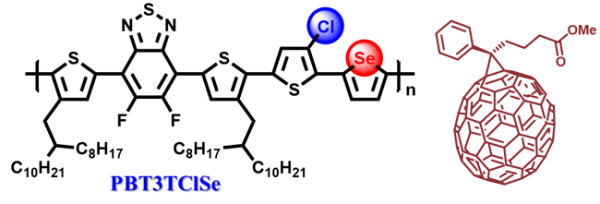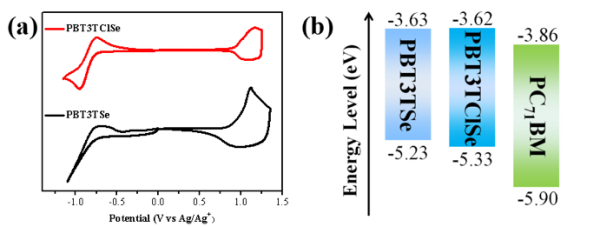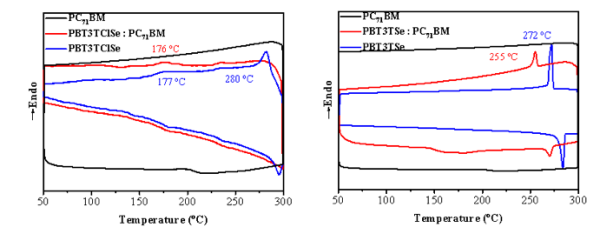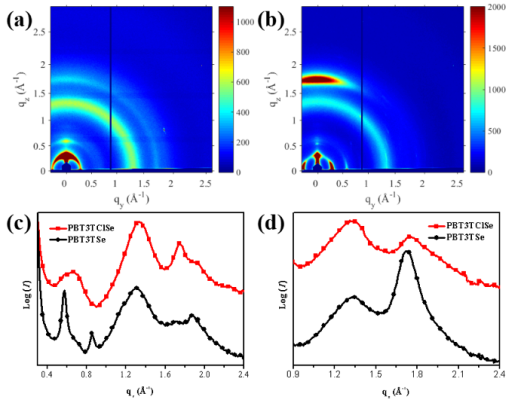Recently, Southern University of Science and Technology (SUSTech) undergraduate student Zhong Xiaowei from the Department of Chemistry had a paper published in an internationally renowned academic journal Macromolecules, with the paper titled “Synergistic Effect of Chlorination and Selenophene: Achieving Elevated Solar Conversion in Highly Aggregated Systems.” Her research is mainly about the chlorine-substituted donor polymer solar cell materials. Prof. He Feng was the corresponding author of this paper.

Polymer solar cells (PSCs) have been attracting increasing attention from researchers due to their lower cost, lighter weight and finely tuned molecular structures. They also feature the potential for large-area solution processing and can be used in flexible electronics. PC71BM is a mature commercially available product that is already widely used as an acceptor material in PSCs. It currently provides high photovoltaic performance with power conversion efficiency (PCE) of nearly 12% from fullerene-based solar devices.

The PCE of the device is proportional to the open-circuit voltage (VOC) and short-circuit current (JSC). Introducing selenophene to donor polymers could enhance the crystallinity so as to improve JSC, but always result in poor VOC. Chlorinated substitution could effectively ameliorate it. Hence, Zhong Xiaowei synergistically investigated the application of selenophene units and chlorine atoms, in order to determine the relationship between the morphological characteristics of the polymer and the photovoltaic performance. Two different polymers were designed, with the polymer containing both selenophene units and chlorine atoms showing higher photovoltaic performance.


The study ultimately concludes that the polymer containing both selenophene units and chlorine atoms features a great clustering property which is thought to be an inferiority in solar devices. This research reveals that such cluster here could shorten the molecular distance to ensure better charge transport, leading to a higher PCE approaching 9.89%. It is clear that chlorination is a powerful tool to perfect photovoltaic performances.

The research of Prof. He’s group has been studying the structure and properties of materials by precisely tuning the molecular interactions in recent years. Materials for organic solar cells has been developed through Cl-S, Cl-π and some other supramolecular interactions to adjust the packing and aligning of the organic photovoltaic molecules. At the same time, 2D square micelle was obtained by controlling the growth rate in different dimensions though the π-π interaction of the conjugated polymers, and their electronic behavior is also under exploration. Halogen bonds and some other non-covalent interactions could effectively control the packing and morphology of the organic molecules, achieving both highly ordered materials and improved performances. Chlorinated donor polymers developed by the group have made greatly enhanced PCE and improved device stability, what’s important, the chlorination had become a general strategy in organic solar cells.
Speaking of this research and the results achieved, Zhong Xiaowei said that all the challenges and experiences associated with the scientific research will help her to go abroad for further study. She also expressed her gratitude to the Department of Chemistry at SUSTech for the research and innovation project, which allowed her and other chemistry students at the time to have the opportunity to complete their research objectives relatively independently with the help of teachers.
The research was supported by the National Natural Science Foundation of China, the Shenzhen Science and Technology Commission’s basic research discipline layout project, the start-up funding of the Southern University of Science and Technology, and the funding of the Shenzhen Grubbs Institute. Professor Chen Wei from the Argonne National Laboratory performed the synchrotron radiation testing.
Paper link: https://pubs.acs.org.ccindex.cn/doi/abs/10.1021/acs.macromol.8b02445
Proofread ByXia Yingying
Photo ByDepartment of Chemistry